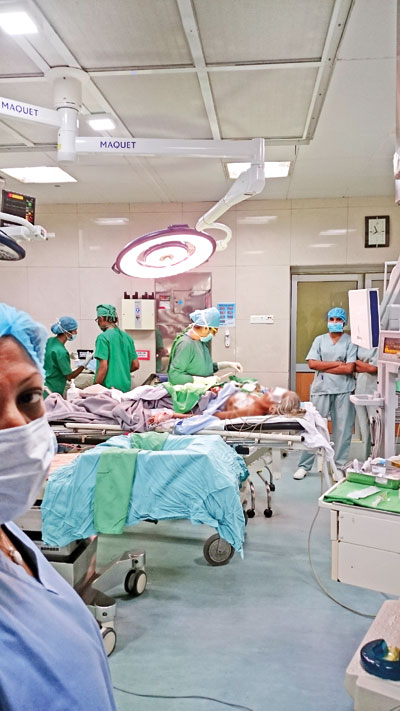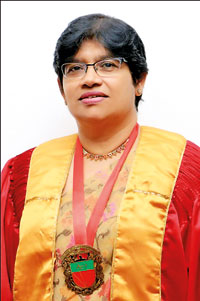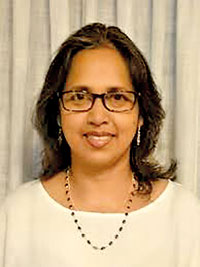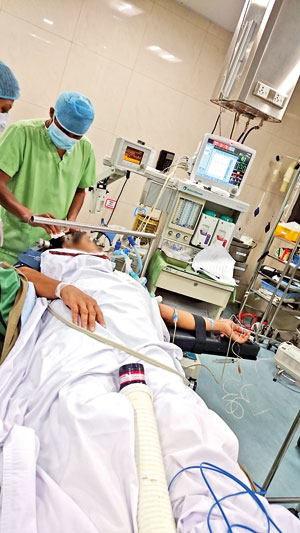There’s nothing to be afraid of anaesthesia

An anaesthetist inserting invasive monitoring on an anaesthetised patient prior to surgery.
Don’t be afraid to be put to sleep for any surgical procedure — anaesthesia is safe and we are by your side throughout. This is the strong assurance coming from the College of Anaesthesiologists and Intensivists of Sri Lanka as the globe celebrated World Anaesthesia Day on Tuesday.
“We have evolved and now there are minimal side-effects when undergoing anaesthesia,” stressed the College’s President Dr. Ramya Amarasena, a Consultant Anaesthetist attached to the National Hospital of Sri Lanka (NHSL), explaining the importance of anaesthesia as a field of medicine. Numerous surgical techniques would not be possible if not for anaesthesia.

Dr. Ramya Amarasena
The College this week launched a public information section on its website: https://anaesthesia.lk/public-information/
Far have we come from the time people were held down physically for the surgeons to perform operations, she reiterates to MediScene, with the College’s Scientific Affairs Secretary, Dr. Loranthi Samarasinghe, going back in time to bring forth the image of John Snow holding chloroform for Queen Victoria, who was in labour way back in 1853, at the birth of Prince Leopold, easing her pain.
“Queen Victoria was so pleased and it was from then on that anaesthesia became popular among the common man,” says Dr. Samarasinghe.
It is Dr. Amarasena who highlights the advancement in anaesthesia techniques and pinpoints the role played by anaesthetists when she says that earlier they were only in the Operating Theatres (OTs) but now there has also been a name-change to peri-operative physicians as they are involved in all stages of managing a patient including pre-op (before surgery), intra-op (during surgery) and post-op (after surgery).
Explaining the process, she says that sometimes patients are seen by General Practitioners (GPs) who refer them to a surgeon if they need an operation, while others come directly to surgeons. Once the date of surgery is set, the surgeon would refer them to the anaesthetist to check out co-morbidities (other diseases) etc.
“In the past, we were only present in the OT and the patient didn’t know who we were. But now we visit the patient in the ward before surgery and draw up an individual plan depending on what the surgery is, how long it will last and what his/her co-morbidities are,” says Dr. Samarasinghe, underlining the fact that they perform ‘prehabilitation’ including breathing exercises to help the patient, working very closely with the surgeon. “We work with the patient to get the best possible outcomes, looking closely at factors such as his/her age and the risk-benefit ratio.”

Dr. Loranthi Samarasinghe
With any surgical procedure needing a multidisciplinary team including physicians, cardiologists, endocrinologists, nephrologists, respiratory physicians, radiologists, nurses, nutritionists and physiotherapists, the anaesthetist takes on the mantle of ‘Coordinator’, MediScene learns.There are guidelines, our own as well as the Royal College of Anaesthetists in the United Kingdom which we follow, according to Dr. Amarasena.
“In Sri Lanka, we maintain a global standard and do not work in isolation,” she says, with Dr. Samarasinghe chipping in that they use tested, tried and proven guidelines, while adapting to Sri Lanka’s own facilities. All the major hospitals have good facilities, it is understood, with 149 Consultant Anaesthetists in the government sector.

A patient being positioned for surgery after being administered anaesthesia.
Both Dr. Amarasena and Dr. Samarasinghe stress that there is also a need for junior doctors as for major surgery the Consultant Anaesthetist will be in attendance throughout but minor surgical interventions can be managed by Medical Officers (MOs) trained in anaesthesia.
Having dealt with staff, MediScene hears about the “major” changes in the field of anaesthesia which has made it safer and more comfortable to undergo surgery:
Pre-op, the Consultant Anaesthetist or MO will visit the patient and have a chat, so that he/she will know who the doctor is. They will relieve stress, let the patient ask any question and look at the critical issue of pain relief. All the routine tests are performed and if any specific test is required for a particular patient depending on his/her condition that too will be done. The usual tests include coagulation (blood-clotting), sugar levels etc.
“In a routine operation, if the patient has co-morbidities, we will see him/her well in advance, so that everything can be attended to early and also check out whether the patient is fit to undergo general anaesthesia (GA) and optimize their physiological state,” says Dr. Amarasena.
Whereas in the past, patients were kept fasting for long hours, as much as 12 to 14 hours, now fasting guidelines are strictly adhered to, even though sometimes it could be challenging to do so in the government sector. Prolonged fasting periods have been found to be detrimental to patients, with more side-effects.
Now the fasting period is six hours for solids and just two hours for clear fluids such as water, plain tea and thambili.
Intra-operatively in major surgery, where earlier there was only basic non-invasive monitoring of blood pressure with the cuff and also basic monitoring of blood gases such as oxygen saturation, carbon dioxide levels and pH levels; ECGs (electrocardiograms) to see the heart function, now state-of-the-art equipment is available for closer monitoring.
Beat-to-beat variation of blood pressure can be monitored now, as also heart functions and a close check can be kept on oxygen entering and exiting the heart and the fluid status in the circulation, say these Consultant Anaesthetists, giving us a view of a sophisticated OT.
Within seconds during the surgery we know what is happening, they say.
Almost all anaesthetic drugs are short-acting with fewer side-effects.
No, we can wake up the patient on the OT table itself, they say, adding that there is minimal hang-over, nausea or vomiting which helps an early return to normalcy and enhanced recovery.
Post-op, the anaesthetists look after the patient in the Intensive Care Unit (ICU) which is an extension of the OT. Post-operative pain management is carried out through nerve blocks, epidural catheters and parenteral (intravenous, intramuscular or subcutaneous) and oral drugs. There are also other techniques by which the patient can control his/her own pain relief, which is called patient controlled analgesia.
Even critically-ill patients who have not undergone surgery but are in the ICU come under the care of anaesthetists for interventions such as ventilation and monitoring Both Consultant Anaesthetists also explain that with the development of anaesthetic medications, whenever possible patients are advised to undergo regional anaesthesia – spinal or epidural, with nerve blocks being administered. Regional anaesthesia has been made easier as scans enable the location of nerves, minimizing complications. There is quicker recovery with regional anaesthesia.
Critical incidents such as death on the OT table due to anaesthesia are rare. Death due to anaesthesia is 1 in 300,000, they add.
| Monitoring the depth of anaesthesiaAn oft-asked terrifying question is: “Will I wake up in the middle of the operation, although I have been put under general anaesthesia (GA)?” No, assure Consultant Anaesthetists Dr. Ramya Amarasena and Dr. Loranthi Samarasinghe, going into detail how major advances have been made with regard to the monitoring of the “depth of anaesthesia”.Too deep or too light the anaesthesia is what we have to be meticulous about – it has to be just right, says Dr. Samarasinghe. During major surgery under GA, the patient’s spontaneous ventilation is taken over by a machine and is manipulated by the anaesthetist to give optimum oxygenation during the procedure.Adds Dr. Amarasena: Ventilation is tailor-made for the patient. (Artificial ventilation is used to assist or replace a person’s spontaneous breathing and may involve a ventilator.)Earlier, whether the patient would wake up during the surgery was the worst nightmare of an anaesthetist, MediScene learns, with all that being part of the distant past now.Fluid balance is optimized meticulously and the cardiovascular stability is maintained throughout the surgery. Earlier, tracheal intubation could be risky, says Dr. Samarasinghe, pointing out that it could be very difficult to do so too, in certain instances. Within seconds, if this procedure is botched, the patient could become hypoxic (deprived of oxygen) and suffer serious brain damage and go into a vegetative state or die. All that has changed now, with high quality equipment such as the video laryngoscope and fibre optic techniques. | |
| What is anaesthesia? This refers to the practice of blocking the feeling of pain to allow medical and surgical procedures to be undertaken without pain, say the Consultant Anaesthetists, Dr. Ramya Amarasena and Dr. Loranthi Samarasinghe.An ancient Italian practice was to cover a patient’s head with a wooden bowl and beat on it repeatedly until the patient lost consciousness. Obviously, this method resulted in a number of side-effects the patient would not have found beneficial, they smile, explaining that opium and alcohol were also regularly used to produce insensibility, both of which had a number of negative side-effects and neither could dull the pain completely.Delving into history they say that few operations were possible and speed was the determinant of a successful surgeon. Patients were often tied or held down and the abdomen, chest and skull were effectively inoperable. Surgery was a last, and extremely painful, resort. Here are the milestones in this journey:October 16, 1846 — An American dentist, William Morton, proved to the world that ether caused complete insensibility to pain during an operation performed in front of a crowd of doctors and students at the Massachusetts General Hospital. Morton instructed the patient to inhale the ether vapour and, once the patient was suitably sedated, a tumour was removed from his neck. The patient felt no pain. This demonstration transformed medical practice.In two months, Drs. Francis Boott and James Robinson in London, England, performed a tooth extraction using ether and two days after that, Robert Liston performed an amputation. A write-up of these achievements appeared in the London Illustrated News the following year in January which reached Australia in May 1847.A doctor in Launceston in Australia, William Russ Pugh, and Sydney dentist, John Belisario, fashioned ether inhalers based on the diagram in the newspaper. On June 7, 1847, Pugh successfully performed two operations under ether anaesthesia, while Belisario performed two dental surgeries. Both had journalists present. Ether was first used in New Zealand on September 27, 1847, when Colonial Surgeon James Patrick Fitzgerald performed a dental extraction on a prisoner at the Wellington gaol. On the same day, Fitzgerald also performed New Zealand’s first general surgical operation on an anaesthetised patient.During both procedures, the ether was administered by James Marriott, an optical instrument maker, using a vapouriser of his own design. Ether anaesthesia not only resulted in a better surgical experience for the patient, it also allowed doctors time during surgery to develop more refined and complex surgical skills.This is all history now with more advanced drugs and techniques being used when anaesthetizing a patient. |


